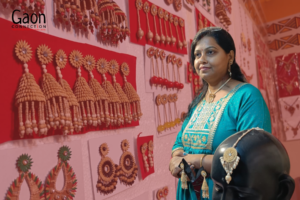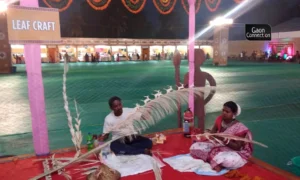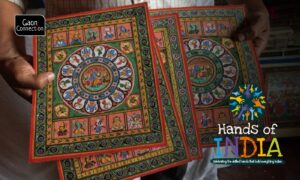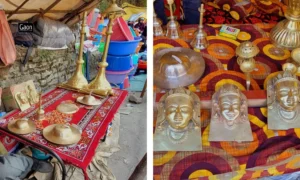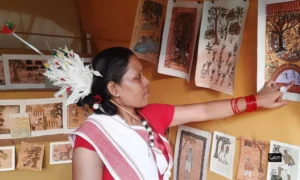Srinagar, J&K
It is an old part of Srinagar, where the roads are narrow and winding, with bylanes leading off into the innards of the city. Some of these lanes are so narrow, no vehicles can go in.
Old brick buildings line the area interspersed with a profusion of shops stacked with copperware (Kashmiris use a lot of copper vessels) and every now and then there is a flash of crimson where Kashmiri chillies have been put out to dry. In the distance can be seen the Mosque and not too far off is the muddy Jhelum river with doongas (a precursor to the shikara) bobbing on them.
At one time, in this Khankahi Sokhat area of Srinagar, almost every household had someone making Namdas, the coarse, sheep-wool floor rugs that can be found in almost every Kashmiri household.
“This craft was widely practised, but not anymore,” Farooq Ahmad Khan, a 40-year-old Namda maker whose family has been in this business for generations, told Gaon Connection. On the top floor of his home, the finished Namdas are hanging out to dry.
The shaggy, rough textured rugs added warmth and a splash of colour to the Kashmiri homes in the grey cold days of winters, said Farooq. “This artwork is a Kashmiri specialty and the colourful elements from beautiful Nature with its birds, leaves and trees are replicated with embroidery on the Namda,” the weaver said.
According to him, there was a time when hundreds of women embroidered the Namdas, but the numbers have dwindled now.
Mehmood Ahmad Shah, Director Handicrafts Department, Srinagar told Gaon Connection that there were 236 people associated with the Namda craft in Srinagar.
“We have built craft centres, and we provide raw materials to the establishments as well as the businesses. The department also promotes innovation and development in product marketing and design,” the official said. These craft centres for now are functioning in Srinagar, in Kunzar in Baramulla, and in Kanihama village in Budgam district.
But it is a long road ahead before the craft becomes robust once again. “We can no longer make a living out of Namdas,” Bashir Ahmad Bhatt who lives in Nowhatta in Srinagar, told Gaon Connection. “After the pandemic and the Russia-Ukraine war the demand for them has dipped. I was forced to take up mattress making in order to make ends meet,” the Namda craftsperson added.
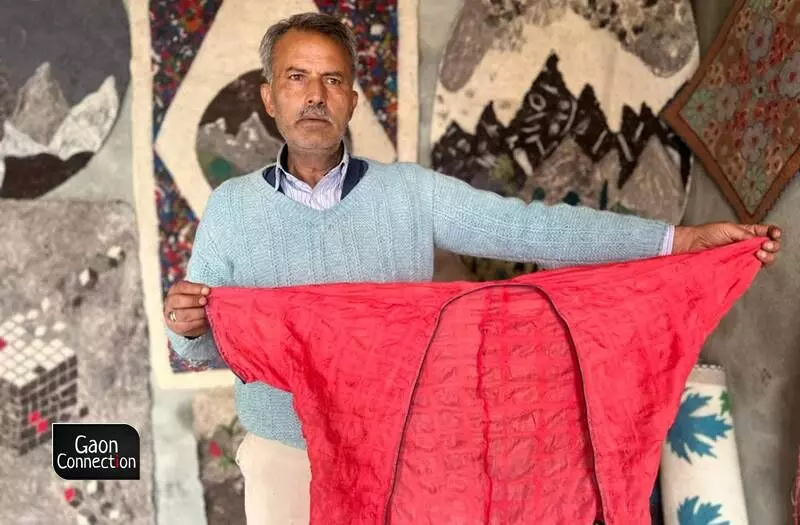
There were two initiatives announced under the Pradhan Mantri Kaushal Vikas Yojana (PMKVY). One was ‘Recognition of Prior Learning’ and a special pilot project called ‘Revival of Namda Craft of Kashmir’.
Also Read: Kashmiri carpet weavers burn the midnight oil to weave silk kaleens for the new Parliament building
An ancient craft
The Namda dates back to the Mughal era, and is said to have been patronised by emperor Akbar. Srinagar was historically a hub of arts and crafts, and the Namda was made by people across castes and creeds, and they earned a decent livelihood from it. A lot of Kashmiri families earned a livelihood from it and there was a demand for them abroad too, especially Russia.
But, government apathy and troubled times in the 90s led to the craft fading away, complained the weavers, and most artisans abandoned it altogether to find more lucrative alternatives.
“The raw material for the craft, sheep’s wool mixed with a little cotton, also dwindled, and there was no move to address that or promote the skill. This has left Namda-making struggling to survive,” Farooq said.
Also Read: Beating the cold with handmade coal in Kashmir
An Australian technique to weave Namda
In 2019, Farooq attended a programme at J&K government’s Craft Development Institute in Srinagar, that invites specialists and experts in crafts to come there and introduce local artisans to new techniques. It was there that Farooq met with a Delhi-based designer, Gunjan Jain, who introduced him to the nano-felting technique that could turn things around.
Traditionally, the Namda is made up of multiple layers of flattened coarse wool (dyed or unbleached), spread out on a jute mat and sandwiched together. Each layer is sprayed with water and pressed down with a tool known as a pinjra, and left to dry. After which, the embellishing with embroidery is done.
The Australian technique of ‘fixing’ that Farooq has incorporated into his Namdas has made the process much faster. “Earlier we would do ari embroidery on it, that was a long drawn out process with the needle and thread. But now we just ‘fix’ motifs of coloured wool into the Namda. This saves so much time,” he said.
Farooq used the new technique along with traditional methods of the craft to give Namda a fillip. Besides traditional wool, he now works with other textiles too. He claimed to be the only one in Kashmir to use the Australian technique that has allowed him to make the Namda craft more versatile.
Also Read: The Banana Fibre Weavers of Anegundi
“I never thought I would be able to adapt it to the Namda craft, but after a lot of effort and with the grace of Allah, I was successful,” he said.
“It took me a long time to learn how to press loose fibres, usually sheep’s wool, into delicate textiles like silk using the nano- felting technique,” admitted Farooq, but he did not give up and managed to “to add fresh life into this fading craft,” he said.
“I now use this method to create brand-new handicrafts such as silk carpets, and scarves. It has allowed me to bring Namda into the modern world,” he said.
“This new technique has made Namda easier and faster to make. And, it has allowed for making the Namda-craft adaptable to other soft furnishings such as curtains, upholstery, bed covers, etc., and not just as carpets,” Farooq pointed out. “Traditionally a small Namda used to take us more than two days to complete, but with the new technique, the time is halved. We can make a Namda a day,” Farooq said.
The price of the traditional Namda ranges between Rs 1,200 and Rs 2,500 depending on its size. The Namda that Farooq makes now is priced between Rs 3,150 and Rs 3,800. The Namdas that are exported start anything upward of Rs 7,400, he said. Generally the price of the Namda is between Rs 90 to Rs 180 a square foot.
In a month, Farooq makes about 40 pieces to be sold across the country in exhibitions and fairs. And a few are exported too. “In the earlier days, Russia was a huge market for Namdas. I export the Namdas there as well as to Japan,” he said.
Last year, on November 27, 2021, Rajeev Chandrasekhar, Union Minister of State for Skill Development and Entrepreneurship, launched a pilot project to revive and promote traditional Namda craft in the Union territory of Jammu & Kashmir.
There were two initiatives announced under the Pradhan Mantri Kaushal Vikas Yojana (PMKVY). One was ‘Recognition of Prior Learning’ and a special pilot project called ‘Revival of Namda Craft of Kashmir’.
The pilot project is an industry-based training programme to encourage young people to come forward to be trained, so that they can revive and preserve the distinctive Kashmiri craft.







